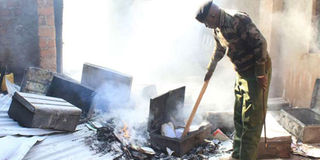Neither coddling nor threat of prison will stop student riots

Kisii County Administration Police Commander Mohammed Kutsola inspects the scene of a fire at Naikuru PAG Secondary School where students burnt a boys' dorm on June 29, 2016. PHOTO | BENSON MOMANYI | NATION MEDIA GROUP
What you need to know:
- The Ministry of Education Science and Technology, through various task forces, has already identified the most common causes of dangerous unrest.
- What is required is to implement suggested solutions in a holistic fashion, and to do that, all the stakeholders must be involved – parents, teachers, students, educationists and ministry bureaucrats.
About two years ago, a young distant relative approached me with a sob story about how his father had refused to pay his secondary school fee arrears. As a result, he moaned, he was about to be sent home. And because I occasionally suffer from bouts of unreasonable generosity, I gave the money to him the following day.
Two weeks later, I was to learn the error of my ways when it emerged that the innocent-looking chap had criminal tendencies; he and his mates had been planning to burn down their school, and some of the Sh3,000 I had given him was to be used for the purchase of petrol. In other words, I had been duped to facilitate arson, a situation that would have landed me in the fire, quite literally.
I later learnt that the fellows were protesting the decision to change the school from a mixed day to an all-boys boarding school. Needless to say, the lusty chaps were expelled and the last I heard was that they ended up in other schools. Seems like the heads of some schools in rural areas cannot bring themselves to ask too many questions when money is pressed on them.
The recent spate of arson during which buildings in six schools were gutted has made parents, teachers and education authorities start wondering what evil wind hit them. It might appear strange that all the incidents occurred in one region, but this could be a simple case of copy-cat manifestations of a hankering for pyrotechnics. Thus, it is idle to speculate that this unrest is a reaction to the tough new rules announced recently to curb exam cheating. These rules are not even in operation yet.
To put it mildly, many people are shocked that secondary students should destroy school property – and the meagre belongings of fellow students – with such abandon. Such things don’t just happen, they argue, there must be a deep underlying cause, because the ordinary student is not innately evil.
How come, those of the old school ask, dormitories and administration blocks were never set ablaze in their day? True, students would occasionally riot when the food they got was inadequate or badly prepared, but that was about it. It is, therefore, amazing that a few students can run amok and burn down their school because they were not allowed to watch a football game on television.
The solutions offered to these problems range from the genuinely compassionate, like Education, Science and Technology Cabinet Secretary Fred Matiang'i calling for dialogue with students before things get out of hand, to the hardball calls for the criminal elements to be jailed and the keys thrown away.
There is something to be said for both suggestions, but there are also drawbacks. Democratising education can only work to a certain extent. As a teacher, you cannot be expected to be forever negotiating with your wards; there must be good reasons why you are the teacher and they the students. You are more educated, and presumably wiser. You are much older and certainly more experienced. A situation where students can be allowed to vote on every issue would be a recipe for real anarchy.
On the other hand, the argument by hardliners is a non-starter. It is true that arson, a crime in itself, can result in attempted or actual murder, which is a capital offence. Therefore, offenders who are under-age should be detained at the President’s pleasure. That’s the law. But unless these chaps are caught in the act, then all other evidence will be circumstantial. How do you get around that?
The other option is even weirder. Some schools have reportedly installed surveillance cameras to check on the movement of their students. That is gross abuse. You simply cannot turn a school into a prison. What is even worse is that some school managers have been boasting about buying killer dogs, ostensibly to scare away thieves and keep students in. Suppose one of those animals went berserk and started mauling everyone in sight?
What has been happening in our institutions is a real tragedy but the solutions must be well thought-out. The ministry, through various task forces, has already identified the most common causes of such dangerous unrest. What is required is to implement suggested solutions in a holistic fashion, and to do that, all the stakeholders must be involved – parents, teachers, students, educationists and ministry bureaucrats.





